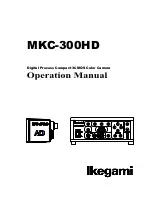
SU320CSX
4110-0446, Rev. B
Page 7 of 96
© 2016 UTC Aerospace Systems
Date Printed: 5-Dec-2016
This document does not contain any export controlled technical data.
1.4.
Safety Considerations
The camera can be powered using a DC power supply capable of providing a minimum of 4 Watts of
continuous power. The camera is supplied with an appropriate universal mains power supply. Do not
exceed the voltage maximum or damage might occur.
If you supply your own power, it is critical that the power connections be made to the proper connector
pins. See Section 2.1.3 Power, Trigger, and Sync for details.
The focal plane array is mounted behind a broadband antireflective-coated protective window. When
changing lenses or mounting the camera in any optical arrangement, take care not to scratch or touch this
window.
To prevent fire, shock hazard or damage to the camera, do not expose to rain or excessive moisture. Do
not disassemble camera. Do not remove screws or covers. There are no user serviceable parts inside.
Removal of any panel will void the warranty.
When handling the camera, take precautions to avoid electro-static discharge (ESD) to any exposed
electrical connector pins.
1.5.
Thermal Management
Caution: Do not power the CSX camera until you have considered thermal management. The
camera itself does not dissipate heat quickly enough to prevent over-heating under all conditions.
Monitoring of the camera case temperature, system temperature, and thermoelectric cooler (TEC)
lock are highly recommended to prevent overheating. The case temperature can be monitored by a
user-supplied thermocouple or other sensor. System temperature closely tracks case temperature,
and can be queried with the SYSTEM:TEMP? command as described in Section 5.15.1 Get System
Temperature. The camera can be placed in a higher TEC setpoint to reduce power consumption
with the MACRO command as described in Section 5.20.1 Play Macro Command. If the camera
temperature is too high, forced convection from an external fan or conduction to an external heat
sink is highly recommended. Due to the small size of the camera, the camera may overheat within
minutes of applying power if no external cooling or heat sinking is provided.
The CSX camera has been designed to efficiently transfer heat from the focal plane array and other heat-
generating components to the chassis. The camera will function properly while the chassis temperature is
maintained within the specifications listed in Table 1.
Table 1. The case temperature can be measured anywhere on the camera chasses, the system temperature
and TEC lock status can be queried as described in sections 5.15.1 Get System Temperature and 5.15.3
Get TEC Lock Status. The MACRO command changes camera TEC setpoint as described in Section
5.20.1 Play Macro Command. TEC is locked when the thermoelectric cooler is able to maintain the FPA
at its setpoint. The camera will lose TEC lock when the low or high case temperature for a given TEC
setpoint is exceeded. See
Table 1 for the case temperatures that correspond to each TEC setpoint.








































